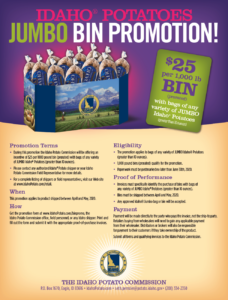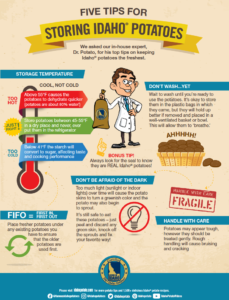Apr 9, 2020Foodservice-to-retail shift has potato industry adjusting on the fly
The ongoing COVID-19 pandemic has turned the food industry upside down.
Most sit-down restaurants have been forced into takeout or delivery only, while some have shut down altogether temporarily. Meanwhile, grocery stores have struggled to keep pace as folks stock up with anticipation that they’re going to be home much more than normal for an unknown amount of time.


The vast number of people eating at home instead of eating out has led to a spike in fresh potato sales — March shipments of fresh potatoes were 11% higher than last year — which has put significant stress on the supply chain and resulted in uncertainty surrounding potato demand from foodservice.
Idaho Potato Commission (IPC) CEO and President Frank Muir said the IPC staff, which includes Vice President of Retail/International Seth Pemsler and Vice President of Foodservice Alan Kahn and six full-time field representatives, have been working virtually “around the clock with shippers and customers.”
“There has been an unprecedented shift from foodservice to retail,” Muir said. “We had higher shipments that first week (of coronavirus shut downs) than we have the week of Thanksgiving.
“The pipeline was not prepared.”
RELATED: Potatoes USA reports show how dependent industry is on foodservice
On the flip side, there were foodservice operators, as well as processors who sell to foodservice, who suddenly didn’t need as many potatoes. Not only have shippers and packers had to pull potatoes out of storage that were intended for foodservice, potatoes ready for foodservice had to be rerouted to retail.
“You’ve got these 50-pound cartons of (large) foodservice-sized potatoes that need a home,” Muir said. “Now you’re educating retailers how to make displays out of these 50-pound cartons. It worked out OK, but we had to refill that pipeline after that first rush.”
Change in trends
Consumer trends also went by the wayside. The demand for 3- and 5-pound bags of fresh potatoes has been steadily trending up in recent years, but the want for large-size russets in larger quantities, including 10-, 20- or even 50-pound bags, returned almost overnight.


“We are working with them on the best ways to utilize potatoes for takeout,” Muir said. “The good news is that more people ordered from restaurants (the week of March 30-April 5) than the week before. Who knows how long this is going to go on? The restaurants that do the best at drive-through, delivery and curbside are the ones that are going to survive the best.”
Communication with consumers also has been a key, as IPC, Potatoes USA and other organizations have been distributing best-practice information for storing and cooking potatoes, as well as recipes and ways to get children involved in preparing them.
“You bought 50 pounds of potatoes, so now what do you do with them?” Muir said. “The last thing we want is to have people have a bad experience because they weren’t stored properly.” The IPC is providing several ways to inform consumers how to store potatoes and how to easily prepare them in a wide range of recipes.
Muir said the long-term ramifications of the pandemic’s effect on the potato industry and where the retail-foodservice ratio demand is going to go are impossible to know because “we have no idea how long this is going to go on.”
Industry effects
“We’re suggesting to our growers to be conservative (in planting projections),” he said. “You can’t use the last five years to plan because this isn’t like the last five years.”


In addition, efforts are underway from the National Potato Council and state potato associations to work with the federal government to make sure specialty crop growers get assistance with the COVID-19 relief package. The efforts include making H-2A guest worker processing a priority and government purchasing of produce to be distributed in food assistance programs.
Muir noted that retail demand showed one of the first foods people turned to when the crisis hit were potatoes.
“I think the positive thing is that the country is rediscovering potatoes,” he said. “We’ve been pounding the message that potatoes are healthy and good for you for 15 years.”
Downloadable recipes, potatoes best-practice information and other resources are available at idahopotato.com and potatoesusa.com.
Top photo: A potato display at Community Market in Greenfield, Ohio, in 2017.
– Zeke Jennings, VGN Correspondent















